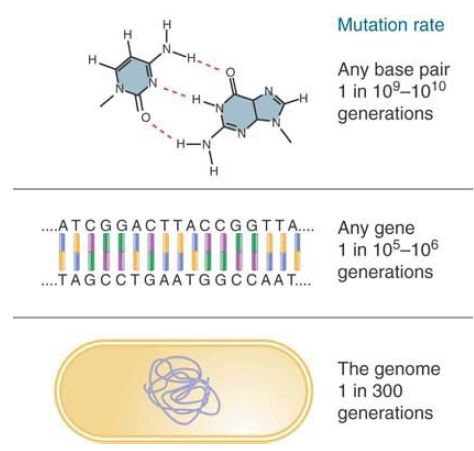


 النبات
النبات
 الحيوان
الحيوان
 الأحياء المجهرية
الأحياء المجهرية
 علم الأمراض
علم الأمراض
 التقانة الإحيائية
التقانة الإحيائية
 التقنية الحيوية المكروبية
التقنية الحيوية المكروبية
 التقنية الحياتية النانوية
التقنية الحياتية النانوية
 علم الأجنة
علم الأجنة
 الأحياء الجزيئي
الأحياء الجزيئي
 علم وظائف الأعضاء
علم وظائف الأعضاء
 الغدد
الغدد
 المضادات الحيوية
المضادات الحيوية|
Read More
Date: 9-5-2016
Date: 9-5-2016
Date: 10-3-2021
|
Mutations Change the Sequence of DNA
KEY CONCEPTS
- All mutations are changes in the sequence of DNA.
- Mutations can occur spontaneously or can be induced by mutagens.
Mutations provide decisive evidence that DNA is the genetic material. When a change in the sequence of DNA causes an alteration in the sequence of a protein, we can conclude that the DNA encodes that protein. Furthermore, a corresponding change in the phenotype of the organism can allow us to identify the function of that protein. The existence of many mutations in a gene might allow many variant forms of a protein to be compared, and a detailed analysis can be used to identify regions of the protein responsible for individual enzymatic or other functions.
All organisms experience a certain number of mutations as the result of normal cellular operations or random interactions with the environment. These are called spontaneous mutations, and the rate at which they occur (the “background level”) is different among species, and can be different among tissue types within the same species. Mutations are rare events, and, of course, those that have deleterious effects are selected against during evolution. It is therefore difficult to observe large numbers of spontaneous mutants from natural populations.
The occurrence of mutations can be increased by treatment with certain compounds. These are called mutagens, and the changes they cause are called induced mutations. Most mutagens either modify a particular base of DNA or become incorporated into the nucleic acid. The potency of a mutagen is judged by how much it increases the rate of mutation above background. By using mutagens, it becomes possible to induce many changes in any gene or genome.
Researchers can measure mutation rates at several levels of resolution: mutation across the entire genome (as the rate per genome per generation), mutation in a gene (as the rate per locus per generation), or mutation at a specific nucleotide site (as the rate per base pair per generation). These rates correspondingly decrease as a smaller unit is observed.
Spontaneous mutations that inactivate gene function occur in bacteriophages and bacteria at a relatively constant rate of 3–4 ×10-3 per genome per generation. Given the large variation in genome sizes between bacteriophages and bacteria (about 103 ), this corresponds to great differences in the mutation rate per base pair.
This suggests that the overall rate of mutation has been subject to selective forces that have balanced the deleterious effects of most mutations against the advantageous effects of some mutations.
Such a conclusion is strengthened by the observation that an archaean that lives under harsh conditions of high temperature and acidity (which are expected to damage DNA) does not show an elevated mutation rate, but in fact has an overall mutation rate just below the average range. FIGURE 1. shows that in bacteria, the mutation rate corresponds to about 10 events per locus per generation or to an average rate of change per base pair of 10-9 –10-10 per generation. The rate at individual base pairs varies very widely, over a 10,000-fold range. We have no accurate measurement of the rate of mutation in eukaryotes, although usually it is thought to be somewhat similar to that of bacteria on a per-locus, per-generation basis. Each human infant is estimated to carry about 35 new mutations.

FIGURE 1. A base pair is mutated at a rate of 10-9 –10-10 per generation, a gene of 1,000 bp is mutated at about 10-6 per generation, and a bacterial genome is mutated at 3 × 10-3 per generation.



|
|
|
|
مخاطر عدم علاج ارتفاع ضغط الدم
|
|
|
|
|
|
|
البحرين تفوز بجائزة أفضل وجهة للمعارض والمؤتمرات
|
|
|
|
|
|
|
مدرسة دار العلم.. صرح علميّ متميز في كربلاء لنشر علوم أهل البيت (عليهم السلام)
|
|
|